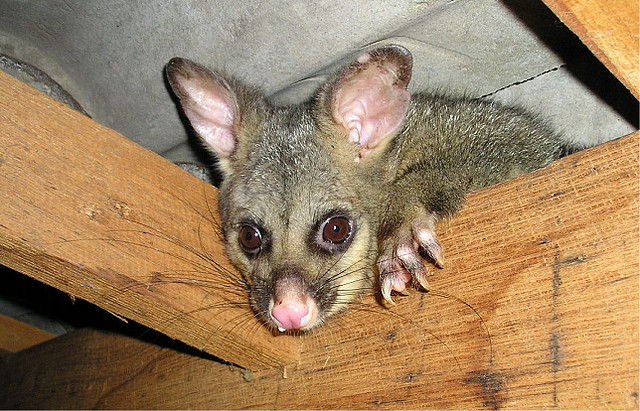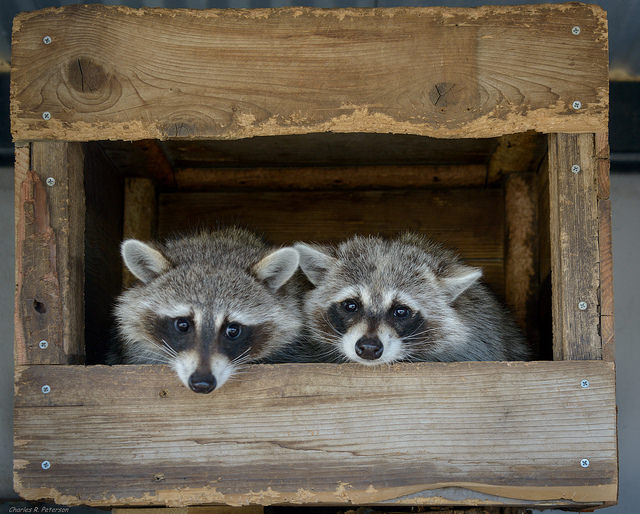How to Live Trap a Wild Animal the Humane Way
Summer is here, and wild animals are more likely to be seen and heard at closer range than we’d like. Sometimes unwanted animal visitors create havoc around your property or in your home, which makes them quite a nuisance and not-at-all welcome. This just might be the time to learn about how to live trap a wild animal the humane way.
How to Live Trap a Wild Animal the Humane Way
You may need to have the animal vacate your premises for safety’s sake — it’s and yours. Maybe the animal is dangerous or may be causing unsanitary conditions, especially if you have young children around. Or they may be ruining your garden or destroying your eaves.
There comes a time when you can’t ignore the problem, and you have to do something about it. You could find a way to kill it — poison it perhaps, or shoot it, but I hope you won’t go this route.
Two questions to ask yourself before attempting to trap an animal are:
- Can I do this legally (comply with state laws regarding trapping and transporting wildlife? and
- Can I do this humanely? (see “Options for What to Do with the Trapped Animal“).
If the answer to either of these is no, consider hiring a professional who is better able to meet these ends (see Hiring a Wildlife Damage Control Company for information).
How to Live Trap a Wild Animal the Humane Way
First, you have to know what the problem is, exactly. You have to know the size and type of animal you’re dealing with. Is it a tiny rodent making nests in your attic? Perhaps it’s a groundhog digging tunnels on your lawn, or a larger raccoon rummaging through your garbage cans. It could be a feral cat or a stray dog, or it could even be a skunk or possum.
Choosing a Live Trap
Once you know the size of the animal, you can [amazon_textlink asin=’B0000AVWMX’ text=’start shopping for an appropriately-sized live trap’ template=’ProductLink’ store=’animalbliss-blog-20′ marketplace=’US’ link_id=’4c7efe51-e5ae-11e6-93e6-a1a7598af462′]. The trap should be large enough to fit the animal inside, but small enough that the animal doesn’t have too much space to move around.
Live animal traps vary not only in size, but also in the number of doors, ease of use, and other helpful features. To learn more about the different traps available, read about the various Trap Types at the Havahart website.
Where to Put Your Live Trap
The best place to put your trap is outside of its hole or den, if you know where that is, or in an area where you see it appears most often, such as near your garbage cans. Make sure it’s on a flat surface so that the animal can’t tip it over once it’s trapped and injure itself.
Bait the Live Trap
You’ll want to use food to lure the animal into the trap and position the bait in such a way that the animal will be forced to step on the live trap trigger plate, which will, in turn, shut the trap door and safely trap the animal inside.
You might have to try different foods, depending on the animal. Do some research to find [amazon_textlink asin=’081173417X’ text=’animal-specific instructions and trapping tips’ template=’ProductLink’ store=’animalbliss-blog-20′ marketplace=’US’ link_id=’9905e77e-e5ae-11e6-847e-9dbaa034db49′].
Setting Your Trap
Once you have your trap, read the instructions on how to set it correctly. Anchor the trap, so it won’t tip over or misfire when the animal enters—an animal will not enter a tipsy trap, and misfires teach it not to try and enter again. Anchor the trap with a cinder block or other heavy object placed on top, or you can wire or clamp the trap to a stable object.
Check Your Trap Often
You want to trap the animal humanely, remember, and the longer it’s trapped, the more it will become anxious, scared, and hungry. So check your trap frequently and release as soon as possible.
After an Animal is Trapped
Once you have captured the animal, move the trap to a quiet, protected spot and cover it with a cloth or tarp to help keep the animal calm until you can release it. Release it as soon as possible to avoid further stress.
Many wild animals can carry diseases, so wear gloves and hold the trap away from your body. Release the animal in natural surroundings, at least 5 miles away.
Release nocturnal animals at night and diurnal species during daylight.
Point the opening of the trap away from you, toward escape cover, so the animal can see and move toward it. Open the door, and tap the trap with your foot. If the animal is reluctant to leave, try placing the open trap on its side and moving away from the trap.
When releasing an animal that has a potential to bite or spray, attach a long string to the door of the trap before setting it, so that you can open the door from a distance. Let the animal leave in its own time.
Sanitizing the Trap
Once you return home, disinfect the cage with a solution of 1 part bleach to 9 parts of water. Let the solution sit for 20 minutes before wiping down the trap. Rinse the trap thoroughly after each capture.
NOTE: Never trap an adult animal that is caring for dependent offspring. Look and listen for young—even outside the animal’s known birthing season.
When an adult animal is trapped, look for swollen teats that are relatively free of hair, which indicate it is a female nursing young. (By standing the trap up on end you can usually observe the underneath side of the animal.) In such a case, release the female onsite so she can tend to her young.
Sources:
Images: Raccoons / Possums / Gophers
How to Live Trap a Wild Animal the Humane Way, #animals #wildlife Share on X
A QUESTION FOR YOU: Have you ever had to live trap an animal? What was it? What was your experience with it?
** Please leave your comment below. **
(It’s just sexy!)

![]()
As always, thank you for taking the time to visit my blog!

*
[amazon_link asins=’B000IHDRXM,B000BX1H76,B0000AVYYF,B0045R7OB2′ template=’ProductCarousel’ store=’animalbliss-blog-20′ marketplace=’US’ link_id=’70bfe381-e5af-11e6-8e50-cddae3a537d7′]
*
Disclosure: Animal Bliss is an Amazon affiliate and will earn a (very small, teeny tiny) commission from purchases made through links on this website.
(Coffee money – thank you!)
😀
- Mindful Travel With Your Dog This Holiday Season - December 23, 2019
- A-Z of Australia’s Endangered Wildlife - December 20, 2019
- Teaching Your Kids How to Walk the Dog Safely - December 2, 2019




Great read, people forget that animals need to be treated fairly, even if they end up where we don’t want them to. Thanks for writing.
I like your suggestion that if you can’t do it legally or humanely you ought to call a professional to help trap a live animal. I’ve tried in the past to catch a racoon that was in my basement but it was fruitless as I was ill prepared. Sometimes hiring a professional is worth it anyway because they may have tricks that they know that will be more effective.
When you have a rodent in your home, whether it be a rat or a possum, you need to get rid of it. However, I like how you emphasize catching it live and in a humane way, that is great. I would much rather get rid of the offending rodent in a humane way.
I like your tip to check your trap often. Like you said, leaving an animal in a trap for a long time will cause it to become stressed and hungry. Checking the trap frequently and releasing the animal as soon as possible is the most humane way to get pests out of your home. Thanks for the article.
Although I live in the city I still see racoons, possums and we do have gophers which are illegal to kill in NC. It’s great to know what to do in case I would ever need to remove one from say under my home. It happened to my neighbor a few weeks ago. She called someone but I don’t think they even tried to remove or maybe didn’t know what to do.
One never knows when one might have to remove a pesky critter! My sister had one down in her basement one time. It was a gopher, if memory serves me. They got a live trap and it worked really well for her. I’ve used the live traps too. (I can’t kill anything.) I didn’t know it was illegal to kill gophers in NC. That’s interesting. Are they protected? Thanks for taking the time to visit my blog. I truly appreciate you. 🙂
I love that more people are doing humane traps these days. This is a great, simple tutorial. Since people are impeding on more and more wild animal territory, there are a lot more creatures joining us near our homes. There was a cougar roaming around here in Metro Detroit not so long ago! I would not suggest attempting to trap this animal yourself. LOL
A cougar near Detroit! That’s wild! You’re right … I’d leave trapping that to a professional. I’m so glad you stopped by for a visit, Robin. I always appreciate it when you do. (I enjoyed playing your Turkish Word Search, by the way. What a cool feature to have on your blog.) Take care, and come back soon. 🙂
Thanks for the tip about checking for whether or not there are young and if you have a nursing mother on hand. That’s very important to check for and not something a lot of people would think to check for.
Thanks for your visit and comment today, Val. I’m glad you picked up on that point, about checking to see if there are young or not. That means that other people might take note too. It’s so important. I’m going to visit your site now, to read your interview with Steve Monahan. That should be interesting. Thanks! 🙂
You’re welcome and thanks for visiting to read the interview.
Absolutely! Animal rescue is such a noble cause. Thank you for all that you do. 🙂
Isn’t that the saying, “Relocation, relocation, relocation?” Oh, wait. No … Not quite. 🙂 Thanks for stopping by, Francene. Thank you for your comment.
If the situation arises, it’s good to know that there is a humane way to do this.
Thanks for visiting, Salma! I always appreciate your comments. 🙂
Years ago, my husband and I lived on rural land in Arkansas. One of the ways we earned a living was by raising chickens and selling the eggs to a local health food store. Raccoons were a big problem. They would break into our coop at night and kill chickens. We were living on rural land where our neighbors also had problems with predators (coyotes eating a neighbor’s sheep, for example). So this brought up a dilemma. We always trapped humanely. Those animals were doing what came naturally. But then what? Would a neighbor five miles up the road with chickens appreciate our released raccoon going after his/her chickens? What our rural lifestyle taught us is- there are no easy answers in life.
Oh boy, what a dilemma. There really are no easy answers in that case, unless you could release them somewhere where no one lived. I used to raise chickens and goats, but luckily, I never had problems with raccoon or coyotes, although my neighbors did. One neighbor lost most of her sheep. That was a sad day, let me tell you. Anyway, I’m glad to hear that you were willing to do the humane thing. At least try. Thanks for sharing this with us. I truly appreciate you visit. Until next time … 🙂